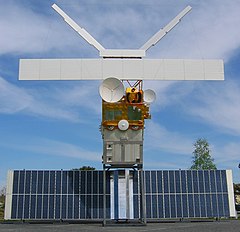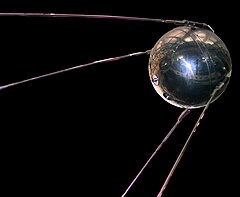This article is about artificial satellites. For natural satellites, also known as moons, see Natural satellite.
For other uses, see Satellite (disambiguation).

A full-size model of the Earth observation satellite ERS 2
The world's first artificial satellite, the Sputnik 1, was launched by the Soviet Union in 1957. Since then, thousands of satellites have been launched into orbit around the Earth; also some satellites, notably space stations, have been launched in parts and assembled in orbit. Artificial satellites originate from more than 50 countries and have used the satellite launching capabilities of ten nations. A few hundred satellites are currently operational, whereas thousands of unused satellites and satellite fragments orbit the Earth as space debris. A few space probes have been placed into orbit around other bodies and become artificial satellites to the Moon, Mercury, Venus, Mars, Jupiter, Saturn, and the Sun.
Satellites are used for a large number of purposes. Common types include military and civilian Earth observation satellites, communications satellites, navigation satellites, weather satellites, and research satellites. Space stations and human spacecraft in orbit are also satellites. Satellite orbits vary greatly, depending on the purpose of the satellite, and are classified in a number of ways. Well-known (overlapping) classes include low Earth orbit, polar orbit, and geostationary orbit.
Satellites are usually semi-independent computer-controlled systems. Satellite subsystems attend many tasks, such as power generation, thermal control, telemetry, attitude control and orbit control.
Early conceptions
"Newton's cannonball", presented as a "thought experiment" in A Treatise of the System of the World, was the first published mathematical study of the possibility of an artificial satellite.The first fictional depiction of a satellite being launched into orbit is a short story by Edward Everett Hale, The Brick Moon. The story is serialized in The Atlantic Monthly, starting in 1869.[1][2] The idea surfaces again in Jules Verne's The Begum's Fortune (1879).
In 1903, Konstantin Tsiolkovsky (1857–1935) published Means of Reaction Devices (in Russian: Исследование мировых пространств реактивными приборами), which is the first academic treatise on the use of rocketry to launch spacecraft. He calculated the orbital speed required for a minimal orbit around the Earth at 8 km/s, and that a multi-stage rocket fueled by liquid propellants could be used to achieve this. He proposed the use of liquid hydrogen and liquid oxygen, though other combinations can be used.
In 1928 Slovenian Herman Potočnik (1892–1929) published his sole book, The Problem of Space Travel — The Rocket Motor (German: Das Problem der Befahrung des Weltraums — der Raketen-Motor), a plan for a breakthrough into space and a permanent human presence there. He conceived of a space station in detail and calculated its geostationary orbit. He described the use of orbiting spacecraft for detailed peaceful and military observation of the ground and described how the special conditions of space could be useful for scientific experiments. The book described geostationary satellites (first put forward by Tsiolkovsky) and discussed communication between them and the ground using radio, but fell short of the idea of using satellites for mass broadcasting and as telecommunications relays.
In a 1945 Wireless World article the English science fiction writer Arthur C. Clarke (1917–2008) described in detail the possible use of communications satellites for mass communications.[3] Clarke examined the logistics of satellite launch, possible orbits and other aspects of the creation of a network of world-circling satellites, pointing to the benefits of high-speed global communications. He also suggested that three geostationary satellites would provide coverage over the entire planet.
The US military studied the idea of what was referred to as the earth satellite vehicle when Secretary of Defense, James Forrestal, made a public announcement on December 29, 1948 that his office was coordinating that project between the various services.[4]
History of artificial satellites

Sputnik 1: The first artificial satellite to orbit Earth.
Sputnik 1 helped to identify the density of high atmospheric layers through measurement of its orbital change and provided data on radio-signal distribution in the ionosphere. The unanticipated announcement of Sputnik 1's success precipitated the Sputnik crisis in the United States and ignited the so-called Space Race within the Cold War.
Sputnik 2 was launched on November 3, 1957 and carried the first living passenger into orbit, a dog named Laika.[5]
In May, 1946, Project RAND had released the Preliminary Design of an Experimental World-Circling Spaceship, which stated, "A satellite vehicle with appropriate instrumentation can be expected to be one of the most potent scientific tools of the Twentieth Century.[6] The United States had been considering launching orbital satellites since 1945 under the Bureau of Aeronautics of the United States Navy. The United States Air Force's Project RAND eventually released the above report, but did not believe that the satellite was a potential military weapon; rather, they considered it to be a tool for science, politics, and propaganda. In 1954, the Secretary of Defense stated, "I know of no American satellite program."[7]
On July 29, 1955, the White House announced that the U.S. intended to launch satellites by the spring of 1958. This became known as Project Vanguard. On July 31, the Soviets announced that they intended to launch a satellite by the fall of 1957.
Following pressure by the American Rocket Society, the National Science Foundation, and the International Geophysical Year, military interest picked up and in early 1955 the Army and Navy were working on Project Orbiter, two competing programs, the army's which involved using a Jupiter C rocket, and the civilian/Navy Vanguard Rocket, to launch a satellite. At first, they failed: initial preference was given to the Vanguard program whose launch vehicle had a strange and uncanny way of exploding on national television. But finally, three months after Sputnik 2, the project succeeded; Explorer 1 thus became the United States' first artificial satellite on January 31, 1958.[8]
In June 1961, three-and-a-half years after the launch of Sputnik 1, the Air Force used resources of the United States Space Surveillance Network to catalog 115 Earth-orbiting satellites.[9]
The largest artificial satellite currently orbiting the Earth is the International Space Station.
Space Surveillance Network
Main article: United States Space Surveillance Network
The United States Space Surveillance Network (SSN), a division of The United States Strategic Command,
has been tracking objects in Earth's orbit since 1957 when the Soviets
opened the space age with the launch of Sputnik I. Since then, the SSN
has tracked more than 26,000 objects. The SSN currently tracks more than
8,000 man-made orbiting objects. The rest have re-entered Earth's
atmosphere and disintegrated, or survived re-entry and impacted the
Earth. The SSN tracks objects that are 10 centimeters in diameter or
larger; those now orbiting Earth range from satellites weighing several
tons to pieces of spent rocket bodies weighing only 10 pounds. About
seven percent are operational satellites (i.e. ~560 satellites), the
rest are space debris.[10]
The United States Strategic Command is primarily interested in the
active satellites, but also tracks space debris which upon reentry might
otherwise be mistaken for incoming missiles.A search of the NSSDC Master Catalog at the end of October 2010 listed 6,578 satellites launched into orbit since 1957, the latest being Chang'e 2, on 1 October 2010.



No comments:
Post a Comment